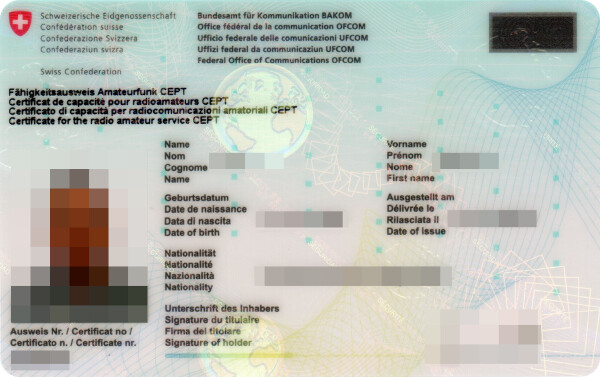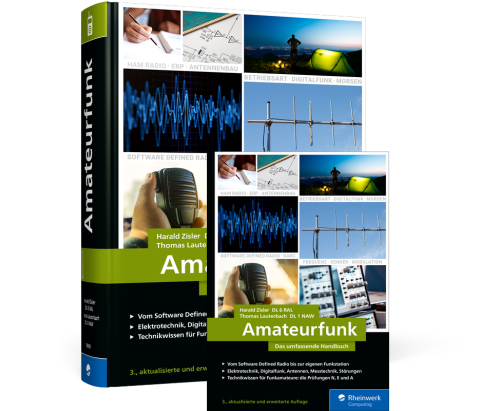From zero to radio amateur license in Switzerland

Introduction
This article explains what it took for me to go from “zero” knowledge to passing the HB9 (CEPT / HAREC) Amateur Radio license in Switzerland1.
I’m hoping to encapsulate useful pointers – as long as it’s still fresh in my memory – in case someone wants to repeat this feat.
tl;dr: Sign up for the ILT Schule online course (if you can spare the cash), read the Amateurfunk book, make flashcards for the regulations, and successfully work through all the question pools you can get your hands on (Swiss, German, US).
Motivation – personal
Why would anyone want to become an Amateur Radioist2? The reasons are many; e.g. HAMs were the original hackers.
For me: having successfully passed the B1 German exam3, I felt the need to put my newly acquired powahs to a practical test.
And since ingesting legacy media is boring4, I set to do something incomparably more fun: learning all the amateur radio tech (and enough of practical German) to pass the license.
Actually, the secondary goal for me was to truly grok the analog electronics, because as lcamtuf@ beautifully put it5:
As a computer geek, I never had much trouble navigating the world of microcontrollers and logic gates. Analog circuitry proved to be a different story […]
(emphasis mine)
Problem statement
In order to pass the exam, one needs to master two very different subtasks that are outlined in the Prüfungsvorschriften Amateurfunk (05.06.2024) doc linked from Funkerprüfungen im Allgemeinen page on BAKOM6 website.
The only allowed materials for the exam are:
- List of frequency bands
- BAKOM-approved list of formulas
- non-programmable calculator
The two tasks in a bit more detail:
Regulations (Vorschriften)
The first one consists of learning, by heart, all the regulations concerning amateur radio operation in Switzerland (and possibly beyond, because they comply with ITU’s T/R 61-01 and T/R 61-02).
Short summary is available as Merkblatt Amateurfunk (25.02.2021) on the Amateurfunk Prüfungen page.
Technical electronics/radio knowledge (Elektro- und Funktechnik)
The second one consists of learning enough of the underlying physics and electronics in order to be able to successfully reason about practical problems.
The exact list of topics is listed in the “Prüfungsvorschriften Amateurfunk” pdf linked above, but contains the usual suspects:
- basic calculations (exponents, decibels)
- Ohm’s law, Kirchhoff’s laws
- Electric / magnetic fields
- Voltage / Current
- Amplification
- Components (resistors, capacitors, inductors, semiconductors, transformers)
- Amplifiers, Modulators, Oscillators, LC circuit
- Filters (low-pass, high-pass, band-pass, band-stop)
- (De-)Modulation (AM, SSB, FM, …)
- Block diagrams
- Antennas
- Electromagnetic radiation (+ wave propagation)
- Measurement tech
- SDR
- Interference (+ protection against)
- Protection (EM fields, lightning)
Solution
I took a significant shortcut by enrolling into ILT Schule, which is one of the providers of courses for Amateur Radio linked directly from BAKOM’s website.
The “Onlinekurs” was well worth the asking price – for me – because it forced me to start at zero7, in German, and go through the basics all the way to the final boss.
It is truly an easy way out if all you’re after is the exam and basic Amateur Radio proficiency. And it’s easily doable in a few months of focused study.
If you don’t have the inclination and/or scratch for what Marcel of ILT Schule is offering, or you simply want to enhance your experience, then read on.
Solving regulations (Vorschriften)
As described in the previous section, the regulations (Vorschriften) must be learnt by heart.
This part is comparatively easy, even though the question pool disappeared from the BAKOM website.
Because – fortunately – USKA8 has your back, as their
Informationen zur Prüfung
lists the [outdated] Swiss question pool as well as the answers. Just ^F
“Vorschriften” on that page.
Still, I highly encourage you to create your own flashcards deck in order to learn all the necessary facts in a minimum amount of time.
My deck for iOS app Flashcards Deluxe
is yours, if you want it: Wejn’s HB9 Vorschriften + Technik xlsx
(csv), but to be fair, I never
bothered to learn the VMax category.
Still, you probably need to know (at minimum) the:
- sub-set of the Q-codes
HF=3..30MHz, etc (and backwards)80m band=3.5 .. 4.0 MHz, etc (and maybe backwards)Zentimeterwellen=300-3000MHz, etcA1A=Morsetelegrafie, etc (and also meaning of the 3 components)
as well as a bunch of harder-to-remember factoids from the next section (Technik)9.
I don’t think there are better shortcuts here than Spaced Repetition, and going through the entire question pool at least once10.
Solving technical knowledge (Elektro- und Funktechnik)
Apart from the ILT Schule course, the single best source I can recommend is the Amateurfunk book:
 Amateurfunk: Das umfassende Handbuch, ISBN 3367100684 / 978-3367100682
Amateurfunk: Das umfassende Handbuch, ISBN 3367100684 / 978-3367100682
The book sports nearly 800 pages, which is somewhat intimidating. But it’s extremely easy to read, and all the topics are well explained.
In order to further prep for the exam specifically, the question pools are also useful:
- CH: again, from USKA: Informationen zur Prüfung,
^F“Technik” - DE: Technik Fragenkatalog für Klasse A, and the associated “Lichtblick” solutions
- (possibly) US: Question pools
Now, you might be asking yourself why I’m listing Swiss, German, and even the US question pools.
Well, during the exam, I’ve encountered questions from both the German and US Extra pool11. And BAKOM is apparently working on an updated list of formulas12 (and possibly question pool).
So it doesn’t hurt to at least thoroughly pass through the CH and DE pools, and if you have time, then skim the US one.
(Also, pro tip: if you happen to own a reMarkable epaper device, you can ask someone to blot out the correct answers in the PDFs, and then you can happily compute the answer and check the correct answers with an eraser. Worked a treat for me…)
Exam
A few words about the exam.
As outlined above, one is not supposed to use anything but a BAKOM-published frequency band, BAKOM-approved list of formulas, and a non-programmable calculator.
For the non-programmable calculator I settled on “TI 30X Pro MathPrint”, despite being a long term Casio fanboy13.
The exam itself was done on a tablet. It was composed of 40 multiple-choice questions and was supposed to take something like 90 minutes. I was done in little over 30 minutes, and left with a sour taste in my mouth, because it was super easy compared to my expectations14.
I think you need ~75% of correct answers, but don’t quote me on that.
Closing words
Where we go from [t]here is a choice I leave to you.
I hope this sums up the basics of the “zero to HB9 license”. If you have questions, shoot me an email.
-
To put it simply: HB9 level gives one unrestricted access to the entire amateur radio spectrum, as well as the permission to build / modify transmitters at will.
Which would be equivalent to either General or Extra Class exam in the US; but I couldn’t be bothered to actually figure out which. (happy to be enlightened via email) ↩ -
I can see you cringe all the way from here. ↩
-
For which flashcards made out of the extract from Goethe Zertifikat B1 Wortliste were a crucial ingredient, btw. ↩
-
And possibly even actively harmful to one’s mental health… ↩
-
If you want to easily grok a bunch of electronics / radio concepts (and more), you could do a LOT worse than deep diving into the nutritious heaven that are lcamtuf’s published articles. ↩
-
BAKOM (Bundesamt für Kommunikation) is the regulating body in Switzerland. ↩
-
Full disclosure: I had it significantly easier because – language barrier aside – I’ve had plenty of basic understanding of electronics since I’ve been through the motions during high school. So Ohm, Kirchhoff, PN-junction and other stuff didn’t scare me much.
Hell, I once breadboarded a non-inverting opamp circuit with exactly 10x amplification (to one decimal) on a dare to legally skip the rest of Friday class… an exercise that involved filing down the resistors of the voltage divider to get them to the exact values needed.
Fun times. Superficial, but fun. ↩ -
USKA (Union Schweizerischer Kurzwellen-Amateure): That would be the Swiss equivalent of ARRL. ↩
-
But that’s highly individual. You can see my dirty laundry, but it is unlikely to match your dirty laundry. ↩
-
The fact it has a bunch of errors shouldn’t faze you. E.g. the
/pvs/mfiasco. ↩ -
Which I figured out on the train ride home, by searching for the one weird question I couldn’t answer on the interwebs. ↩
-
And if you want a more readable version of the current one – even if incomplete – have at it: BAKOM Formelsammlung Wejn Incomplete. LaTeX source available for the low price of saying “pretty please with a cherry on top” in Czech. ;) ↩
-
The Casio FX991ES Plus 2nd edition I bought during my learning process ain’t half bad, but the TI 30X Pro MP is better, despite its warts. Because it remembers history even after shutdown, and allows you to paste previous results into the current (partial) input. ↩
-
I guess it was part lucky draw, and part over-prepping on my side. ↩